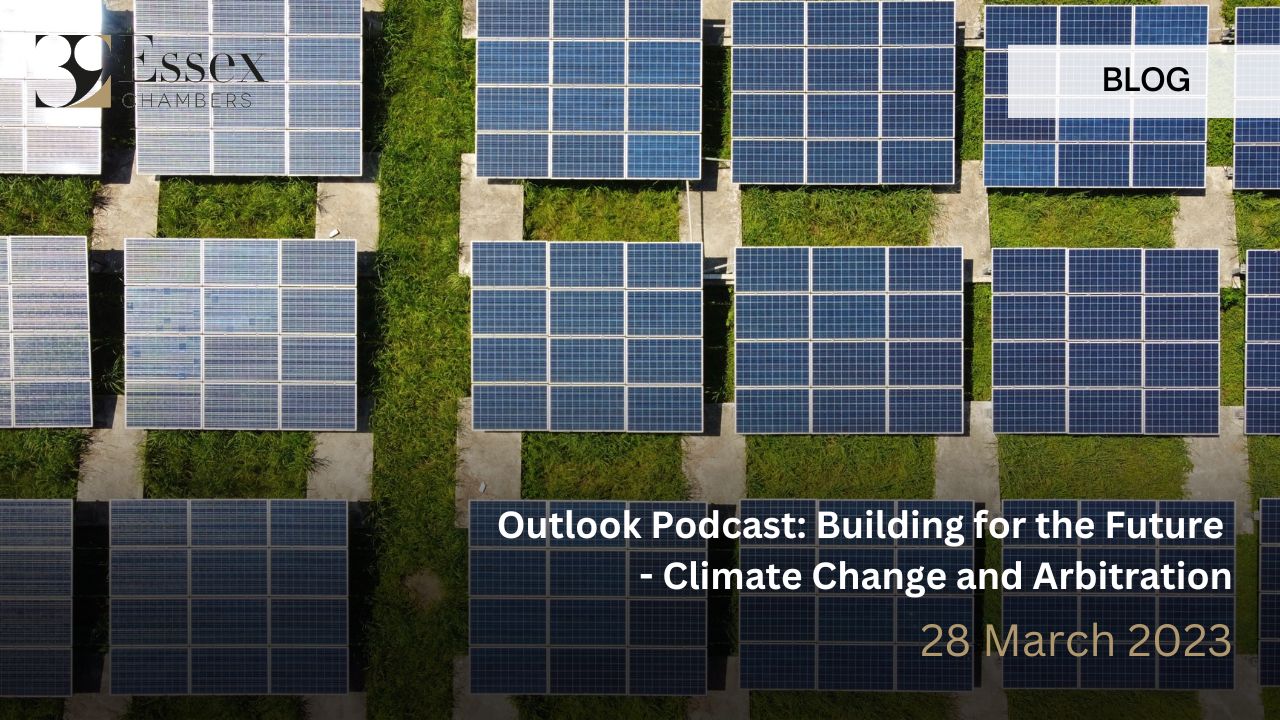OUTLOOK: Building for the Future - Climate Change and Arbitration
 In this episode Camilla ter Haar and Ruth Keating discuss ‘Building for the Future – Climate Change and Arbitration’ with Jessica Crow. Jessica is an independent arbitrator (Arbitra International) who specialises in Energy and Natural Resources, Climate Change and the Environment, General Commercial Disputes and Public International Law, based out of London and Washington DC. She has particular expertise in matters relating to the energy transition and the international climate change regime. This episode focusses on the trends in climate change and arbitration – with a particular focus on what these trends mean for our construction sector clients.
In this episode Camilla ter Haar and Ruth Keating discuss ‘Building for the Future – Climate Change and Arbitration’ with Jessica Crow. Jessica is an independent arbitrator (Arbitra International) who specialises in Energy and Natural Resources, Climate Change and the Environment, General Commercial Disputes and Public International Law, based out of London and Washington DC. She has particular expertise in matters relating to the energy transition and the international climate change regime. This episode focusses on the trends in climate change and arbitration – with a particular focus on what these trends mean for our construction sector clients.
Arbitration and climate change disputes
The data from the major arbitral institutions indicates that the users of arbitration are overwhelmingly represented in heavily emitting industries – energy, construction and the financial sectors. Corporates in these industries will be the first to feel changes in regulation as targets become more ambitious – this is where the role of the state becomes significant in investor state arbitrations.
Where there are international parties the features of arbitration may be appropriate, namely:
- neutral law and neutral forum;
- arbitrators with sectoral expertise can be appointed, those with expertise in energy or environmental law for example;
- the procedure of arbitration is inherently flexible – this could mean that certain issues can be fast tracked in a way that might not be possible in litigation.
Climate change matters being arbitrated
Investment treaty arbitration has seen cases of fossil fuel investors suing states for passing more ambitious climate change policies or phasing down certain fuels. These disputes can arise under international treaties like the Energy Charter Treaty. These kinds of disputes lay bare the tension between investment protection for foreign investors in the energy sector and the state’s right to regulate, particularly in an area as pressing as climate change. Other recent trends in arbitration include those concerning renewable energy. For example there have been challenges in relation to changes made to – or indeed revocation – of Feed-in Tariffs (FIT) schemes (designed by governments to promote the uptake of renewable and low-carbon electricity generation) or green credits.
In the commercial sphere, disputes can arise in the same context, where for example, certain technologies such as the combustion engine are being rendered obsolete. In the construction industry, the rising costs of core materials such as steel and cement can put pressure on supply chains and therefore result in disputes. This raises the question of who should bear the risk of price fluctuations of carbon.
Finally, those investing in new or first of their kind renewable energies can always face classic disputes regarding delay and disruption in green infrastructure projects.
Challenges and sensitivities raised by climate change disputes
A fundamental question is who should bear the risk and the cost of the energy transition. This issue arises in the first instance in investor state arbitrations. The example is given of the Netherlands where the state – following its statement that it would phase out coal by 2030 – was hit by multi-billion dollar lawsuits by coal investors.
Given the sensitive nature of issues raised by climate change related disputes, in international investment arbitration this also raises the importance of amicus curiae interventions from other treaty drafting parties, for example on points of interpretation on a particular article or on a concept of public international law. However potentially impacted stakeholders face a very strict admissibility criteria when trying to submit amicus briefs.
There is also the question of precedent. Strategic litigation has been brought to hold states and other actors to account – those cases have been brought with the objective of obtaining judicial statements and wide publicity. In arbitration, confidential between private parties, there is no concept of precedent. This is why appointment of arbitrators with specific expertise is so important.
Construction and climate change
Given the construction industry contributes so significantly to climate change through scope 1, 2 and 3 emissions it is vulnerable to future regulation. The industry is also exposed to the physical risk of climate change through more extreme weather changes, water shortages and flooding – all of which have a potentially significant impact on construction projects and infrastructure. Increasingly, due diligence and reporting requirements will also be relevant to the construction industry.
The aim of climate litigation is to plug the accountability gaps in the Paris Agreement. When those cases are successful, they put pressure on states and in turn private actors.
Finally, in the years to come we are also likely to see development in the principles surrounding tortious claims and the standard of care – this will have an impact on those in the construction industry. That area will be a considerable area of litigation risk.
Tips for the construction industry
- It is vital to be up to speed on the evolving standards on corporate climate accountability. Many countries have already adopted new due diligence requirements. The private sector will need to consider whether it is Paris-aligned and whether it is meeting its corporate standard of care.
- Voluntary reporting and compliance can assist clients; however it is very important not to over promise and under deliver. This exposes corporate actors to the risk of greenwashing claims. Companies need to ensure their business plans are compliant with the Paris Agreement – this is the best insurance against litigation risk in the long-term.
- Companies should proactively audit risks with existing commercial partners to assess the risks of certain events such as regulatory changes or stranded assets. Once that data is available a plan needs to be developed to manage those risks.
To hear more of our discussion, a link to the podcast can be found here.
*Picture credit to: J Anders at Unsplash


